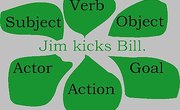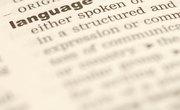In the elementary grades, students learn that nouns are words that represent a person, place, thing or idea. As grammar concepts get more complex in middle school and high school, students need to know more about nouns. Knowing exactly what “job” a noun does in a sentence will help with language issues students face in the upper grades. Students must know the function of the noun in a sentence in order to use the proper pronoun case. Students who understand the different functions of nouns will also have better success learning foreign languages.
Subjects and Predicate Nominatives
Nouns are most commonly used as the subject of a sentence. The subject tells who or what the sentence is about. More difficult to locate is the predicate noun, also known as the predicate nominative. A predicate nominative is a noun in the predicate that renames the subject. For instance, in the sentence “My brother is a chef,” the subject is “brother” and the predicate nominative is “chef.” You will only find predicate nominatives in sentences that have linking verbs rather than action verbs.
Direct and Indirect Objects
Nouns fulfill the role of a direct or indirect object in a sentence. A direct object receives the action of a transitive verb and answers the question “what?” or “who?” about the verb. For instance, in the sentence, “Bob threw a ball,” the transitive verb is “threw.” If you ask, “Bob threw what?” The answer, “ball,” is the direct object. An indirect object will only be found in a sentence that contains a direct object, and tells who or what received the direct object. For instance, in the sentence, “Bob threw Lisa the ball,” we already know that “ball” is the direct object.” If you ask, “Who received the ball?” we find the indirect object, “Lisa.”
Prepositions
Objects of prepositions are found in prepositional phrases, which begin with a preposition and end with a noun. Prepositions show a relationship between the object and another word in the sentence. For example, in the sentence, “Bob put his shoes in the closet,” the word "in" is the preposition and the noun “closet” is the object of the preposition. “In” shows the relationship between the closet and Bob’s shoes. Therefore, the phrase “in the closet” is considered a prepositional phrase.
Appositives
An appositive is a noun that follows another noun and renames, identifies or explains that noun. For example, in the sentence “My brother Bill is a chef,” “Bill” is an appositive because it follows the noun “brother” and identifies the brother as “Bill.” Appositives can also be found within appositive phrases surrounded by modifiers. For example, in the sentence “My dog, a lazy but friendly black Labrador, always greets me at the door when I arrive home," the appositive is “Labrador,” found within the appositive phrase “a lazy but friendly black Labrador.”
Related Articles
References
Writer Bio
Debbie McCarson is a former English teacher and school business administrator. Her articles have appeared in "School Librarians’ Journal" and "The Encyclopedia of New Jersey." A South Jersey native, she is a regular contributor to "South Jersey MOM" magazine.











